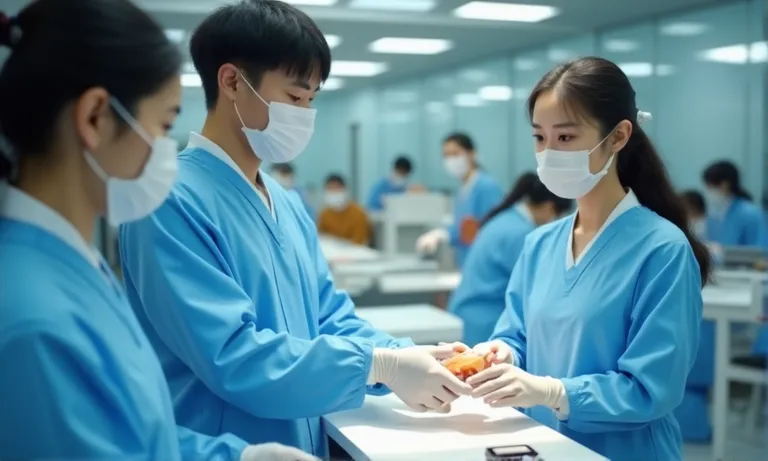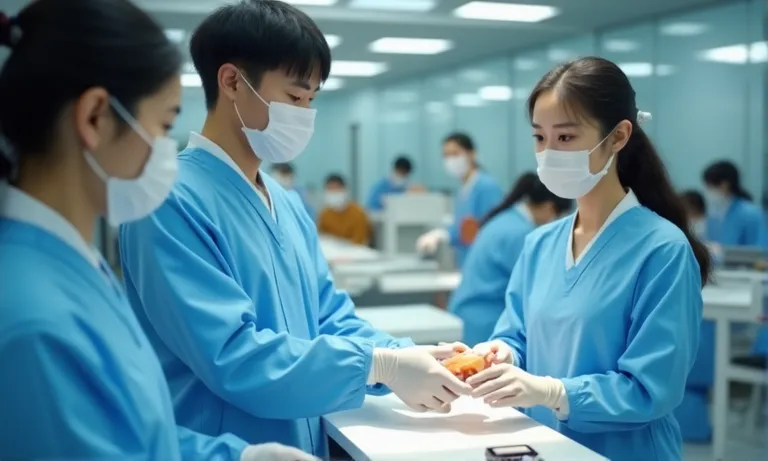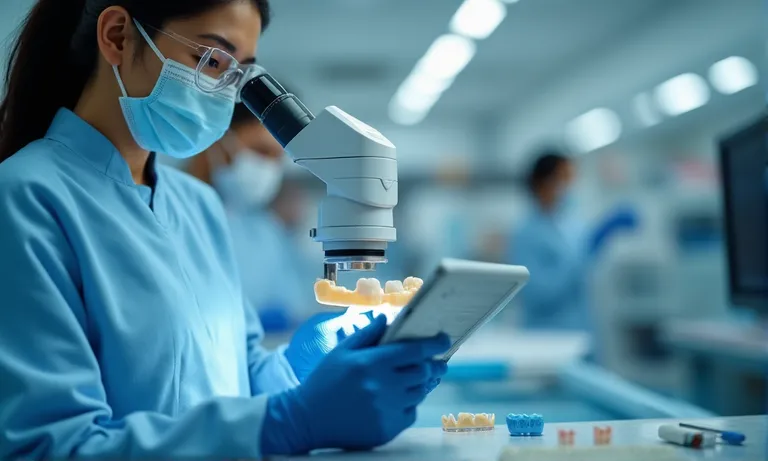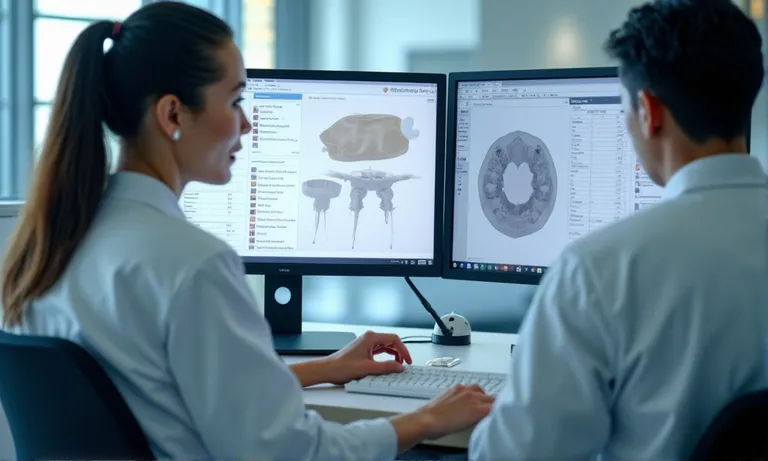Outsourcing crown and bridge cases offers dental practices clear advantages—cost efficiency, faster turnaround, and access to advanced fabrication technologies. But without the right systems in place, these benefits can be undermined by quality inconsistency, communication breakdowns, regulatory gaps, and hidden operational costs.
This guide outlines the most critical risks in outsourcing crown and bridge work—and how to avoid them. Whether you’re working with an overseas partner or a domestic lab, you’ll learn how to:
- Pinpoint the key failure points behind remakes, delays, and unmet expectations
- Navigate regulatory, cultural, and logistical factors that impact outsourcing success
- Define clear SLA terms, documentation protocols, and quality checkpoints
- Strengthen remote collaboration and streamline communication with external labs
- Evaluate lab partners using measurable performance data and compliance criteria
If you’re responsible for case quality, lab procurement, or digital workflow integration—this post gives you the clarity and tools to manage outsourcing with confidence.
Why Do Dental Practices Outsource Crown and Bridge Work?
Dental practices outsource crown and bridge work primarily to reduce overhead, improve efficiency, and expand their restorative capacity—especially as case volume grows or in-house resources reach their limit. Strategic outsourcing provides access to specialized fabrication, faster turnaround, and cost stability across varying case types and materials. Yet the underlying motivation often stems from operational constraints: chairside time is limited, and outsourcing enables clinicians to focus more on patient care, less on logistics. Understanding the drivers behind this decision helps clarify what buyers should prioritize when evaluating lab partners.

dental-lab-outsourcing-reasons
What are the main reasons dental offices outsource crown and bridge cases?
Outsourcing is not just about cost—it’s a strategic choice rooted in resource optimization. The most common drivers include:
- Staffing constraints: Many practices lack the personnel, training, or equipment for in-house fabrication, especially in crown and bridge cases that require specific tools like 3D printers, CAD/CAM scanners, or zirconia furnaces.
- Time efficiency: Clinics can see more patients per day when crown and bridge production is handled off-site. Outsourcing frees up clinical time by offloading case prep, margin trimming, design, and fitting support.
- Material access: External labs often offer a wider range of material options and pre-established workflows for advanced cases such as layered zirconia or implant-supported bridges.
- Quality consistency: By outsourcing to a high-performing partner, clinics can reduce remake rates and standardize outcomes without increasing internal workload.
“For our clients in mid-sized group practices,” notes one project manager from an overseas dental lab we collaborate with, “outsourcing is the only way to handle a fluctuating monthly volume—sometimes 20 cases a week, sometimes 70—without quality slipping.”
How does outsourcing impact cost, turnaround, and case volume scalability?
The impact of outsourcing on key performance metrics can be summarized in the table below:
| Metric | In-House Fabrication | Outsourced Lab Workflow |
|---|---|---|
| Fixed Costs | High (equipment, maintenance, training) | Lower (only pay per case) |
| Scalability | Limited by staff and equipment availability | Flexible (can scale volume up/down rapidly) |
| Turnaround Time | Faster for single cases | Comparable or faster for bulk workflow w/ logistics |
| Material Options | Limited to inventory and tools on hand | Broad selection across systems and brands |
| Case Complexity | Depends on technician skill level | Access to specialist teams and digital support |
In most cases, outsourcing helps stabilize unit costs and improves the lab-to-chair workflow as long as the communication and case planning are strong.
Which types of restorations are most commonly outsourced?
Full-contour zirconia crowns, layered zirconia bridges, and PFM (porcelain-fused-to-metal) crowns top the list of most frequently outsourced crown and bridge restorations. These cases require precision milling and aesthetic layering—tasks that are labor-intensive and sensitive to fabrication error if done in-house without calibrated systems.
Implant-supported crowns are also often outsourced due to the digital planning and abutment customization involved. Practices with high esthetic standards or multi-unit anterior restorations often prefer outsourcing to labs that specialize in esthetics.
In our direct collaborations with DSO groups and independent practices, we often see full-arch zirconia cases routed externally for consistency in shade layering and occlusal morphology.
While temporary crowns and simple posterior units may still be fabricated chairside or with small desktop mills, most permanent restorations with esthetic or functional demand are routed to external labs.
What Are the Biggest Risks in Crown and Bridge Outsourcing?
Outsourcing crown and bridge work offers significant benefits—but only when risks are properly understood and managed. The most common problems relate to quality inconsistency, communication gaps, and hidden operational costs. These issues are especially likely when the lab relationship lacks clarity, quality systems, or accountability. Recognizing these risk factors early is critical for buyers who want stable outcomes, minimal remakes, and long-term trust in their lab partner.

dental-lab-outsourcing-risks
What quality issues typically arise in outsourced crown and bridge work?
Quality risks tend to show up in predictable ways. Based on direct experience supporting DSO teams and independent practices, we often see the following issues:
- Inaccurate margins: Poorly defined digital scans or margin misinterpretation can lead to open margins, overhangs, or improper fits.
- Shade inconsistency: Without a consistent protocol for shade matching or photographic references, esthetic zones may result in patient dissatisfaction or remakes.
- Occlusal interference: Lack of articulation information or improper mounting can cause bite-related problems, especially in posterior cases.
- Substandard materials: In some low-cost labs, sub-tier zirconia or metal alloys may be substituted without disclosure, impacting biocompatibility and long-term durability.
- Finish line miscommunication: When clinicians don’t specify finish line types or clarity is lost during design translation, marginal integrity suffers.
In one recent case from a U.S. DSO partner, five posterior zirconia crowns were returned due to occlusion issues. The remake analysis traced the problem to a lack of confirmed articulation data and a switched STL file version mid-design.
How do communication gaps contribute to remakes or patient dissatisfaction?
Miscommunication is one of the most frequent—and avoidable—sources of failure in outsourced crown and bridge work. It often begins with unclear prescriptions, missing scan references, or last-minute design changes that aren’t confirmed.
Once a scan leaves the clinic, both lab and dentist rely on accurate, timely, and context-rich communication. Without it, the lab may proceed with assumptions that don’t match the clinical reality.
For instance, if a clinician requests “slightly lighter than A2” but doesn’t attach a photo under daylight conditions or fails to note stump shade, the lab cannot reproduce that intent. Or in layered zirconia cases, esthetic parameters such as translucency zones or buccal contour may be left to guesswork.
We’ve seen several practices solve this by implementing structured case intake protocols, where files are checked for critical data points before submission.
What hidden costs or trade-offs come with low-cost outsourcing options?
Below is a comparison of what may seem like “cost savings” on paper versus their downstream consequences:
| Apparent Advantage | Hidden Risk or Trade-off |
|---|---|
| Lower unit price | Higher remake rate increases chair time and lab handling costs |
| Faster advertised turnaround | May reflect rushed QA or batch shipping without case-level review |
| Minimal onboarding needed | Lack of alignment leads to misfits, inconsistent shading |
| Simplified communication | Reduced documentation results in unclear responsibility for errors |
| No case minimum | Less incentive for labs to optimize specific client workflows |
Choosing an outsourcing partner solely on price often leads to unpredictable results. Practices focused on long-term patient satisfaction should evaluate value over cost.
One lab manager from a regional distributor shared: “A client switched to a cheaper provider and soon had to remake 1 in every 5 anterior crowns. Eventually, they returned to us—not because of marketing, but because of consistency.”
How Do Overseas Labs Compare to Domestic Ones in Terms of Risk?
While outsourcing to overseas dental labs offers cost and scalability advantages, it also introduces a different risk profile compared to domestic partners. These risks often stem not from geography itself, but from lack of alignment in regulation, time zone coordination, and documentation protocols. Comparing offshore and domestic labs through these lenses helps buyers set realistic expectations—and choose partners based on process quality, not just location.

overseas-vs-domestic-dental-labs-risk
What are the regulatory, communication, and time zone challenges in offshore outsourcing?
When working with an overseas dental lab, buyers face a few recurring challenges:
- Regulatory differences: Some countries follow ISO or CE standards rather than FDA-specific documentation. While not inherently lower in quality, this requires mutual understanding of which standards govern materials and workflows.
- Time zone misalignment: A 12–15 hour gap between U.S. clinics and Asian labs can slow approvals, revisions, or clarification unless workflows are pre-scheduled. Labs with 24-hour response systems or bilingual night shifts mitigate this issue.
- Communication channels: Offshore labs often rely on written messaging via email, portal, or WhatsApp. Without a structured case intake process, key prescription details can be missed.
- Expectation gap: Cultural assumptions about communication tone, response timing, or “what’s implied” can lead to operational friction unless documentation is explicitly clear.
At Raytops, for instance, we developed “mirror-shift” account reps to align communication windows with U.S. Eastern Time during design revisions—a system that has helped DSO clients reduce revision delays by 28% in multi-unit cases.
Are domestic labs always safer or more consistent?
Not necessarily. While domestic labs often enjoy tighter real-time communication and simplified logistics, consistency still depends on process, not location.
We’ve supported clients who experienced high remake rates from local labs due to limited material choices or outdated scanning equipment. Conversely, some overseas labs—especially those investing in full digital workflows and rigorous QA—can outperform smaller domestic providers on both cost and reliability.
The key is not to assume safety by geography, but to verify based on system transparency, digital traceability, and quality metrics.
As one client told us after switching from a U.S. lab to an overseas team: “The biggest difference wasn’t price—it was that the offshore lab actually logged each STL version and gave us case audit trails.”
What documentation and legal considerations should buyers review?
| Document Type | Why It Matters |
|---|---|
| Material Disclosure Sheet | Verifies alloy type, brand of zirconia, biocompatibility certs |
| Workflow Overview / SOP | Helps the buyer understand design tools, review checkpoints |
| Case Audit Log | Tracks STL versioning, margin edits, shade changes over time |
| Remake & SLA Policy | Defines responsibility, turnaround time, remake conditions |
| Certification Proof (e.g., ISO, CE) | Indicates adherence to recognized international quality systems |
Labs unwilling to share this level of transparency are usually not ready for high-volume, high-accountability partnerships.
How Can You Ensure Quality When Working with Outsourced Labs?
Quality assurance in outsourcing doesn’t happen by default—it must be designed into the relationship. Clinics and procurement managers must take an active role in verifying a lab’s systems, materials, and transparency before and during collaboration. From certifications to audit protocols, there are multiple levers buyers can use to protect case outcomes, especially in crown and bridge workflows where accuracy and repeatability are critical.

dental-lab-quality-assurance-checklist
What certifications, quality systems, or compliance standards should labs follow?
Labs that operate at scale—and with accountability—typically maintain the following:
- ISO 13485: This standard applies to medical device manufacturing and confirms that the lab’s QA system meets internationally recognized medical-grade controls.
- CE Mark / FDA registration: Especially important when dealing with materials or components sourced overseas, confirming regulatory acceptance in the destination market.
- Internal SOPs with case checkpoints: The lab should follow a standardized process with predefined QA steps (e.g., margin verification, scan-to-print tolerance check, shade QC).
- Documented remake policy: A clear policy on turnaround time, remake conditions, and mutual accountability helps prevent disputes during escalations.
- Digital traceability system: Labs with platforms that log STL versions, photo references, and design approvals create a defensible case record, which is essential in high-risk anterior work.
At Raytops Dental Lab, for example, every full-arch zirconia case includes a two-step review: first for CAD margin integrity, then post-sintering shade accuracy. This has helped reduce remake rates on these complex cases by 32% for multi-location clients.
How can you assess lab materials, process transparency, and previous outcomes?
Before committing to volume orders, buyers should review both technical documentation and previous case performance. Request samples that represent the actual workflow—including prep margin transitions, substructure detail, and occlusal finishing—not just cosmetic demo units.
Ask the lab to explain:
- Which zirconia brands they use (e.g., Katana, NexxZr), and whether they can prove batch traceability
- How STL files are versioned and changes logged during the design process
- Whether they store design iterations and photos for post-delivery review
Reviewing remake logs, turnaround variance, and communication trails can tell more about a lab’s reliability than any single sample case. Experienced overseas dental labs often share anonymized case dashboards with remake reasons categorized—a practice many domestic labs still lack.
Should buyers implement a pre-production review or third-party QA audit?
For buyers with standardized workflows or sensitive restorations, we recommend the following steps:
- Pilot-run checklist: Start with 5–10 cases across different restorations. Review quality across fit, shade, turnaround, and communication response time.
- Pre-approval protocol: For anterior or implant-supported units, ask to approve designs before fabrication begins (e.g., screenshot of margin lines, anatomy preview).
- Scheduled QA calls: Weekly or bi-weekly check-ins help catch communication drifts and give structured feedback.
- 3rd-party inspection (optional): Especially for large DSO accounts, working with an independent QA inspector or hiring a regional sourcing agent can help monitor lab adherence to agreed SOPs.
We’ve supported clients who ran dual-track trials with two labs. The one that offered real-time design previews and shared CAD logs won the contract—not because of price, but because of trust and transparency.
How to Prevent Communication and Coordination Breakdowns?
The most preventable issues in outsourced crown and bridge work aren’t due to poor craftsmanship—they’re due to communication gaps. A single missed shade instruction or an unclear margin annotation can cause days of delay or costly remakes. Ensuring seamless coordination between clinics and labs requires structured communication protocols, well-defined checkpoints, and tools that reduce ambiguity.

dental-lab-communication-protocol
What must be clearly specified in prescriptions, scans, and design files?
Breakdowns often begin with vague or incomplete instructions. Every file sent to the lab should explicitly include:
- Margin line definition method (automatic vs. manual, any anatomical reference notes)
- Tooth number(s) and clear restoration type (e.g., PFM, full-zirconia, layered)
- Shade selection with photo reference (under natural light, stump shade if applicable)
- Occlusion and contact instructions (e.g., “light occlusion on #30,” or “tight mesial contact”)
- Special requirements or delivery constraints (e.g., “for patient wedding on July 5”)
- Platform compatibility details (e.g., “scanned via Medit i700, exported as STL v.2”)
In our collaboration with multi-location dental groups, standardizing these data points reduced remake incidence by 37% in anterior zirconia cases over a 3-month span.
How should approvals, revisions, and checkpoints be managed remotely?
Effective remote collaboration requires a repeatable, transparent workflow. A 4-step structure is often effective:
- Design Submission
Lab submits a design preview (margin lines, anatomy form, shade simulation) within 12–24 hours of scan receipt. - Client Approval or Edits
Doctor or designated reviewer sends either approval or annotated feedback using screenshot tools or integrated platforms. - Checkpoint Confirmation
Final spec (e.g., “finalized margin, shade B1, tighten distal contact”) confirmed in writing before fabrication starts. - Post-delivery QA Log
Delivery includes a brief record (e.g., STL version, technician name, shade ref) to support traceability and feedback.
This model is particularly effective when paired with visual tools like PDF overlays or intraoral scan annotations.
What tools or practices help align expectations across teams?
Coordination across time zones and roles requires more than email. Practices that succeed at outsourcing use:
- Structured case intake forms (e.g., Google Forms or lab portal checklists)
- Version-controlled file exchange via cloud platforms like Box or OneDrive
- Chat + task-tracking integration, such as using WhatsApp for real-time questions and Trello for revision tracking
- Centralized photo and STL archive to reference during disputes or repeat orders
- Dedicated liaison or account coordinator who oversees revision flow and ensures response windows (e.g., within 4 business hours)
We’ve worked with several clients who created shared folders named by patient ID, case type, and date. This simple structure eliminated 90% of “which file was final?” confusion.
What to Do When Things Go Wrong: Delays, Remakes, and Inconsistency
Even with the best outsourcing systems in place, issues will occasionally arise—remakes, delays, inconsistent shading, or unexpected patient feedback. What separates high-performing clinics and labs isn’t whether problems happen—it’s how they respond and evolve together. A structured SLA, clear escalation process, and periodic evaluation are essential tools to manage and learn from these moments.

dental-lab-case-remake-issue-escalation
What should be defined in the SLA regarding remake scope and turnaround?
To avoid disputes when cases need to be redone, your Service Level Agreement (SLA) should clearly define:
- Remake eligibility window: e.g., “within 30 days of delivery with original case file available”
- Causes covered vs excluded: Material flaws, margin misfit, or shade mismatch = included; prep design or scan distortion = excluded
- Turnaround expectation: Standard remake SLA (e.g., 4–5 working days); urgent remake SLA (e.g., 2-day express if flagged)
- Photo or STL documentation requirements: Must accompany remake request
- Communication time window: e.g., “confirmation within 24 hrs after submission of a valid remake claim”
Well-written SLAs protect both clinic and lab. At Raytops, we define remake categories into “avoidable vs shared risk,” which helps reduce ambiguity and increase resolution speed.
How do you document and escalate recurring quality problems?
A structured issue-handling process enables trust and course correction. We recommend this escalation flow:
- Case-level incident log
Maintain a tracker noting case ID, date, error type (e.g., open margin, incorrect contact), technician, and resolution. - Monthly or bi-weekly quality review
Set scheduled review calls to go over top 3 most frequent or impactful issues. Discuss root causes and prevention plans. - Error pattern analysis
If the same issue repeats (e.g., incisal edge length too long in anterior crowns), flag for SOP or technician reassignment. - Corrective action request
Send formal CAR form to lab. Include case samples, annotations, and proposed adjustments to workflow. - Client feedback loop
Share lab’s resolution and change plan with your internal team so expectations stay aligned.
We’ve seen DSO clients adopt this model and reduce shade-related remakes by 40% in 6 months.
When is it time to switch labs or restructure your outsourcing model?
Not every issue warrants abandoning a vendor. But the following signs may indicate a deeper misalignment:
- Repeated remakes with no improvement despite feedback
- Missed SLAs without proactive communication or compensation
- Staff turnover on the lab side causing regression in quality
- Lack of access to technician records or STL version tracking
- Non-responsiveness or blame-shifting when concerns are raised
In such cases, consider a pilot run with a second lab while continuing limited volume with your existing partner. This approach helps compare process control, transparency, and responsiveness in real time without disrupting your entire workflow.
One U.S.-based distributor shared: “After escalating the same issue three times with no corrective action, we started parallel trials. The alternative lab won—not by offering lower cost, but by showing they could listen, adapt, and report.”
What Questions Should You Ask When Choosing an Outsourced Lab Partner?
Choosing an outsourced dental lab partner is a strategic decision that goes far beyond pricing or marketing claims. The best partners are not just fabricators—they’re collaborative stakeholders who align with your workflow, quality expectations, and communication style. Asking the right questions helps uncover operational depth, responsiveness, and long-term reliability.

dental-lab-evaluation-questions-checklist
Can they provide performance metrics, sample workflows, and escalation plans?
Before committing, ask for:
- Key performance indicators (KPIs) such as average turnaround time, case volume capacity, and on-time delivery rate for the past 6–12 months
- Sample workflows including how scan intake, design approval, and remakes are managed
- Escalation policy for when issues arise: who responds, how fast, and through what system?
- Revision/resubmission case log anonymized and with outcomes, showing how learning is embedded
- Dedicated account support structure, especially for group practices or multi-site DSOs
Labs that hesitate to share this information may not have the infrastructure for scalable cooperation.
One client we worked with compared three labs. The lab that provided weekly dashboards—even during trial—won the contract, because it showed transparency and readiness to scale.
How do they handle complex cases, urgent needs, or non-standard protocols?
Standard posterior units are easy to handle. But labs prove their value when cases go off-script.
Can the lab:
- Adapt quickly to last-minute prep changes in full-arch cases?
- Coordinate implant components across different brands or platforms?
- Offer priority production slots for urgent patient cases without compromising quality?
From our experience, successful partnerships often start when a lab proves it can manage chaos—like a layered zirconia bridge needed in five days due to an unplanned surgery date shift.
It’s not about promising perfection; it’s about demonstrating controlled flexibility and proactive coordination under pressure.
What is their track record for remake rates, delivery consistency, and client retention?
| Metric | What to Ask | Why It Matters |
|---|---|---|
| Remake Rate | “What is your average remake rate over the past 6 months?” | High remake rates = hidden cost, patient delays |
| Delivery Consistency | “What percentage of your cases are delivered on time?” | Reflects operational maturity and batching control |
| Client Retention | “What’s your average client relationship duration?” | Indicates trust, adaptability, and service culture |
| Trial-to-contract conversion | “How many trial clients become ongoing accounts?” | Measures client satisfaction and onboarding clarity |
We’ve seen clients use these metrics to score labs during selection. One DSO procurement lead shared that retention rate was the most reliable predictor of lab fit.
Conclusion
Outsourcing crown and bridge work is not just a cost decision—it’s a strategic partnership choice. The right lab brings consistency, transparency, and collaborative problem-solving to every case, especially when volume, esthetics, or timelines increase complexity. For dental practices and procurement teams seeking long-term reliability, it’s not about choosing “domestic vs overseas,” but about choosing process maturity, communication alignment, and measurable accountability.
As an overseas dental lab, we’ve seen how structured coordination, transparent systems, and shared quality standards can turn outsourcing from a risk into a competitive advantage.


